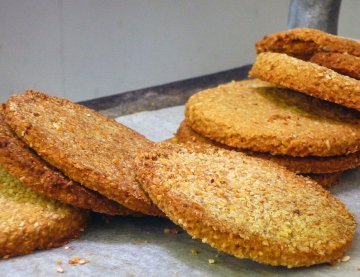
Q: What Were the Honey-cakes of the Beornings?
ANSWER: People often wonder what the honey-cakes that Gimli mentions were supposed to be based on. Many readers mistakenly assume that Tolkien must have had a medieval recipe in mind, although that seems unlikely. The word cake has been used to describe different baked foods. The light fluffy dessert cakes we enjoy today were only developed in the 1600s in England. However, baked sweet breads and bread-like cakes have a long history going at least as far back as ancient Egypt. But before we go too far into the history of cakes and honey-cakes, the record needs to be set straight on who said what. Although it is assumed that Tolkien introduced the honey-cakes in The Hobbit, that’s not entirely accurate. Let us review what Beorn actually did for Thorin and Company when he sent them on their way to Mirkwood:
This is what he promised to do for them. He would provide ponies for each of them, and a horse for Gandalf, for their journey to the forest, and he would lade them with food to last them for weeks with care, and packed so as to be as easy as possible to carry-nuts, flour, sealed jars of dried fruits, and red earthenware pots of honey, and twice-baked cakes that would keep good a long time, and on a little of which they could march far. The making of these was one of his secrets; but honey was in them, as in most of his foods, and they were good to eat, though they made one thirsty….
When the elves of Lorien provide supplies to the Fellowship of the Ring, they include a special gift: wafers of lembas, the elvish waybread. Gimli compares them to the “honey-cakes of the Beornings”:
In the morning, as they were beginning to pack their slender goods, Elves that could speak their tongue came to them and brought them many gifts of food and clothing for the journey. The food was mostly in the form of very thin cakes, made of a meal that was baked a light brown on the outside, and inside was the colour of cream. Gimli took up one of the cakes and looked at it with a doubtful eye.
`Cram,’ he said under his breath, as he broke off a crisp corner and nibbled at it. His expression quickly changed, and he ate all the rest of the cake with relish.
`No more, no more!’ cried the Elves laughing. `You have eaten enough already for a long day’s march.’
`I thought it was only a kind of cram, such as the Dale-men make for journeys in the wild,’ said the Dwarf.
`So it is,’ they answered. `But we call it lembas or waybread, and it is more strengthening than any food made by Men, and it is more pleasant than cram, by all accounts.’
`Indeed it is,’ said Gimli. ‘Why it is better than the honey-cakes of the Beornings, and that is great praise, for the Beornings are the best bakers that I know of; but they are none too willing to deal out their cakes to travellers in these days. You are kindly hosts!’
‘All the same, we bid you spare the food,’ they said. ‘Eat little at a time, and only at need. For these things are given to serve you when all else fails. The cakes will keep sweet for many many days, if they are unbroken and left in their leaf-wrappings, as we have brought them. One will keep a traveller on his feet for a day of long labour, even if he be one of the tall Men of Minas Tirith.’
The lembas is crisp and therefore seems to be a hard-baked bread. It is most likely “twice-baked” like Beorn’s cakes. Twice-baked cakes harden during the second baking process. There are many recipes for twice-baked cakes, some calling for baking icings and toppings onto the cakes.
However, Tolkien may have had something like Italian Biscotti or hard bisquits in mind when he wrote about these twice-baked cakes. The English word bisquit is in fact derived from Latin (panis) bis coctus, which means “(bread) twice-baked”. Ancient hardtack recipes have been refined and differentiated across centuries and countries. Many of these hard breads soften over time.
Some people suggest that the Beornings’ honey-cakes may have contained fruits or nuts. That seems unlikely, although there is certainly a historical precedent for using honey in the baking of breads going back at least as far as Egypt. Actual honey-cake recipes may have included fruits and nuts; recipes for such cakes date to the 1200s and may be considered medieval. Although these types of pastries may have lasted longer than normal breads, there seems little indication that they would have been used by armies on campaigns or by sailors as the hardened twice-baked bread cakes were.
So why didn’t J.R.R. Tolkien call these twice-baked cakes biscuits? Quite possibly the philological purist in him balked at the idea. The modern word biscuit has come to denote something entirely different, especially in England. Now, an English biscuit is an American cookie. These fun snack foods are not what Tolkien had in mind for his waybreads.
The cram Gimli refers to may be some sort of press cake recipe, which would not be very palatable. Archaeologists have found remnants of Viking flat breads throughout Scandinavia. These breads were hard like biscuits and may have been twice-baked as well. They usually were made from two types of grain; barley was almost always an ingredient.
In the legend of Isildur there is a reference to “wafers of waybread” that the Numenorean soldiers carried which would last a long time and sustain a man, being similar to the elvish lembas. The word wafer is ultimately derived from a Frankish word for “honeycomb”; the texture of the Numenorean wafers was therefore probably similar to the hard, twice-baked breads described above.
Addendum: 2017 Research on Honey Nut-cakes

It has come to my attention that there are old German recipes for “honey nut-cakes” that J.R.R. Tolkien was probably very familiar with. Also, oat cakes are based on an ancient recipe dating to Roman times. Although I cannot find any reference to long-lasting oat cakes they do appear to match the style of the wafers Tolkien describes in his stories.
Here is a recipe for a “honey nut-cake” that, when made properly, will keep for a year. This recipe was published in the 1904 Bulletin of the Ontario Department of Agriculture.
Honey Nut-cakes. 8 cups sugar, 2 cups honey, 4 cups milk or water, 1 lb almonds, 1 lb English walnuts, 3 cents’ worth each of candied lemon and orange peel, 5 cents’ worth citron (the last three cut fine), 2 large tablespoonfuls soda, 2 teaspoonfuls cinnamon, 2 teaspoonfuls ground cloves. Put the milk, sugar, and honey on the stove, to boil 15 minutes; skim off the scum, and take from the stove. Put in the nuts, spices, and candied fruit. Stir in as much flour as can be done with a spoon. Set away to cool, then mix in the soda (don’t make the dough too stiff). Cover up and let stand over night, then work in flour enough to make a stiff dough. Bake when you get ready. It is well to let it stand a few days, as it will not stick so badly. Roll out a little thicker than a common cooky, cut it in any shape you like. This recipe originated in Germany, is old and tried, and the cake will keep for a year or more. — Mrs. E. Smith.
Thank you, Mrs. Smith. I think you will have helped generations of Tolkien fans experience something similar to what the good Professor had in mind.
What led me to this recipe was a passing glance at an entry in “The Etymologies”, which while not nearly as useful for describing Middle-earth as many people wish, sometimes adds a little clarity to a long-standing mystery. What I found was this entry:
“KRAB- press. N cramb, cram cake of compressed flour or meal (often containing honey and milk) used on long journey.”
That’s not quite the same as the “Honey Nut-cake” recipe cited above, but the Bulletin contained many recipes and this nut-cake would obviously be good to take on journeys. Take all that for what it’s worth.
See also:
- How Much Land did the Beornings Control?
- What Were the Beornings Like?
- Who Were Beorn’s Followers?
- Did Grimbeorn the Old Have any Sons?
- What Does Beorn Mean?
- Was Beorn in the Hobbit a Were-bear?
- Beorning Questions
# # #
Have you read our other Tolkien and Middle-earth Questions and Answers articles?

In the Italian translation for my The One Ring rpg I translated Beorn’s cakes indeed as ‘biscotti’. I am glad to see you suggesting the same interpretation with your usual flair and precision.
Thank you. BTW — Hawke has been discussing your game with me. He has said many complimentary things about it. You’ll have the opportunity to hear some of his ideas in an upcoming episode of Middle-earth Talk Radio (although I did struggle with your last name in that episode, but only because it was late and I was tired — I apologize in advance).
That’s terrific! I very much look forward to listen to the episode. Please give my regards and heartfelt thanks to Hawke, I really appreciate the attention he is giving to the game. And congratulations for your articles here: this is my go-to place for reference and inspiration.